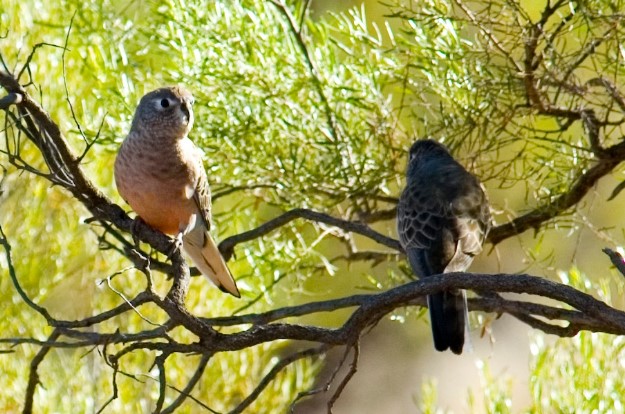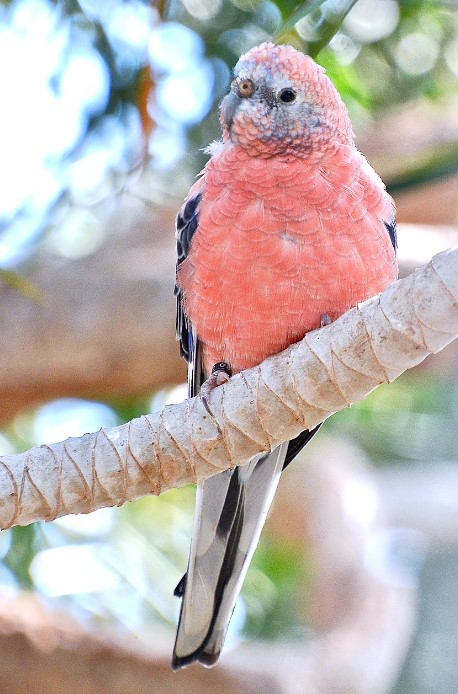Behavior & Habitats: In contrast to early parrots, Bourke’s Parrot is moderately common throughout the mulga woods of the interior, and its numbers have probably increased since the 1950s due to stock watering points. Acacia species, particularly mulga, and spinifex plains are the main habitats for Bourke’s parrots.
The color pattern of Bourke’s Parrot enables it to be distinguished from other species. Nevertheless, the Neophema parrot’s tail is characterized by its second and third innermost pairs of feathers almost equidistant from the central pair. A male stands erect with its tail spread and its wings open in its display. Due to its reddish feathers, the Bourke’s parrot blends in with the soil in its arid habitat.
Their movements are irregular, as they are nomadic. The Bourke’s Parrot is typically found in pairs or small family groups, but if there is a drought, flocks of 100 or more may gather at waterholes. The birds arrive at the water before dawn and after dusk regularly, sometimes not settling down to roost until 9-10 pm. Although they drink occasionally during the day, they spend most of their time feeding on the ground on seeds, often legumes, or resting in bushes and low trees.
Read More – Paradise Parrot (Psephotus pulcherrimus)

Flight: This parrot’s flight is swift and direct, with short glides on partially spread, down-swept wings interspersed with quick shallow wing beats. While traveling between trees, it usually flies close to the ground in quick bursts. An audible whirring sound is produced by the bird’s wing beat.
Diet: Foraging for grasses and grains often takes place at dusk and dawn, when Bourke’s parrots are most active. As a result of their diet, Bourke’s parrots are known to disperse seeds.
Size: A Bourke’s Parrot has a length of about 190 mm, including its slender tail. It weighs 45 grams.
Males have a blue forehead, lines above their eyes, and flecks of white around their eyes. The back and crown are grayish browns. There is brown intermixed with blue on the rump and upper tail coverts. The shoulders and wing coverts are brown with cream edges. Dusky flight feather underwing coverts, bend of the wing, and outer webs are a medium blue color. A brown throat and breast with pink feather edges; a rose-pink belly; and pale blue vent, undertail coverts, thighs, flanks, and upper tail coverts. An outer tail feather is blue with a white tip; a central tail feather is brown and tinged with blue. The eyes are brown. The bill and cere are blackish in color. The toes and feet are mid-dark greys. Female birds are duller, without blue eyebrows.
Immatures: The underwing stripe is off-white in females and sometimes in males as adults, but less pink on the belly. After four to five months, adult plumage develops. Young Downy: Yellow-billed, white-downy.

Call: The Bourke’s Parrot’s contact call is a mellow, repeated chu-wee. While perching, there is often a plaintive, rolling whistle, almost a soft warble. Alarm note with two syllables, kik-kik-kik.
Breeds & Nest: The Bourke’s parrot is a monogamous bird, staying with the same partner for life. Breeding and nesting occur between August and December. It nests in a small hollow, usually in an acacia or casuarina tree, 1-3 meters above the ground. Mulga trees or other species of acacia tend to have hollow limbs where they nest from 1 to 3 meters above ground level. Any potential intruders or threats are chased away by males during nesting season.
Eggs: The Bourke’s Parrot lays three to six eggs, which are white in color and measure 20-21 x 17-18 millimeters. The female incubates the egg for about 18 days. It takes about four weeks for the young to fledge. For another week or so, both parents feed the young.
Read More – Golden-shouldered Parrot (Psephotus chrysopterygius)

Distribution: Bourke’s parrots are native to Australia. It has a large range due to its nomadic nature, following water and food sources. From Ashburton River and Morawa in Western Australia eastward to Ivanhoe and Lightning Ridge in NSW, the Bourke’s Parrot can also be found in native cypress and open eucalypt woodlands.
Other Names: It was named after General Sir Richard Bourke, Governor of New South Wales from 1831 to 1837. It is also called the blue-vented parrot, sundown parrot, pink-bellied parrot, Bourke’s parakeet, Bourke, or “Bourkie”. Burke’s parrot (Neopsephotus bourkii, formerly Neophema bourkii) is a small, genus-exclusive parrot of Australia.
Races: No races exist.
Read More – Scarlet-chested Parrot (Neophema splendid)








